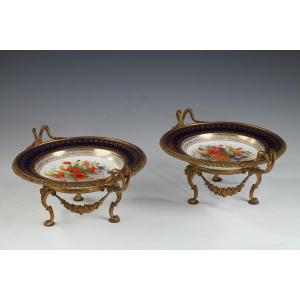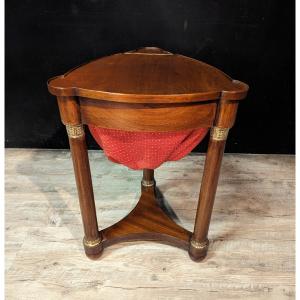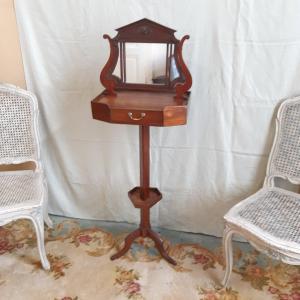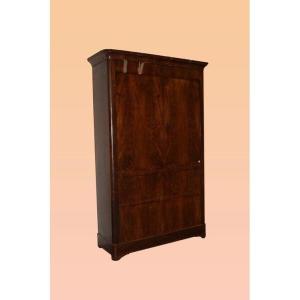Elegant Empire period dressing table in mahogany and mahogany veneer attributed to P.-B. Marcion, decorated with rich chiseled and gilded bronze ornamentation. Surmounted by an oval-shaped psyche mirror, decorated with a frieze of ivy and small flowers, with uprights each supporting two light-arms. Composed in the lower part of a console covered with a black marble top, it opens on the belt with three drawers, richly decorated with palmettes, surrounding a central cartouche in projection decorated with two winged victories embracing an allegorical figure and revealing a sliding tablet forming a writing desk.
It is supported by two console uprights at the front and two pilaster uprights at the rear, resting on a concave-shaped plinth ending in casters.
The ancestor of the dressing table appeared during Antiquity in the form of a dressing table, named after the cloth placed on it. In the Middle Ages, women used ordinary tables on which polished metal mirrors were placed.
In the 18th century and during the first half of the 19th century, the dressing table became essential and responded to a social reality, with important people receiving their guests while they were preparing themselves.
Precious woods and rich gilded bronze ornamentation are used for these pieces of furniture, which, beyond their practical aspect, also reflect the social status of the person who owns them. Some talented cabinetmakers transformed the dressing table from a practical piece of furniture into a piece of furniture with transformations and combinations, and some models, like the dressing table presented here, can also serve as a writing table or a game table.
Biography :
Pierre-Benoît Marcion (1769-1840) worked as a
cabinetmaker from 1798 to 1817 and was one of the main suppliers of Napoleon I
after Jacob, specializing in mahogany furniture decorated with gilded bronzes. His
first official order was the delivery of 82 mahogany chairs for the Senate in
1801. From 1805 onwards,
he regularly supplied the Garde-Meuble Imperial, including most of the athéniennes
for the imperial palaces. Initially established at 41 rue
Neuve-des-Petits-Champs, he moved in 1801 to 666 rue Helvétius (Saint-Anne)
then to 3 rue de Choiseul from 1811 to 1816. He mainly supplied the Pavillon du
Mail, the Petit and Grand Trianon, the Palais de Compiègne, and Fontainebleau.
Upon the return of the Bourbons, he had the supplies made during the last years
of the Empire paid for and abandoned cabinetmaking in 1817.
Bibliography :
Les Ébénistes du XIXe siècle, Denise Ledoux-Lebard, Editions de l’Amateur, 1984, pp.461-469.


































 Le Magazine de PROANTIC
Le Magazine de PROANTIC TRÉSORS Magazine
TRÉSORS Magazine Rivista Artiquariato
Rivista Artiquariato